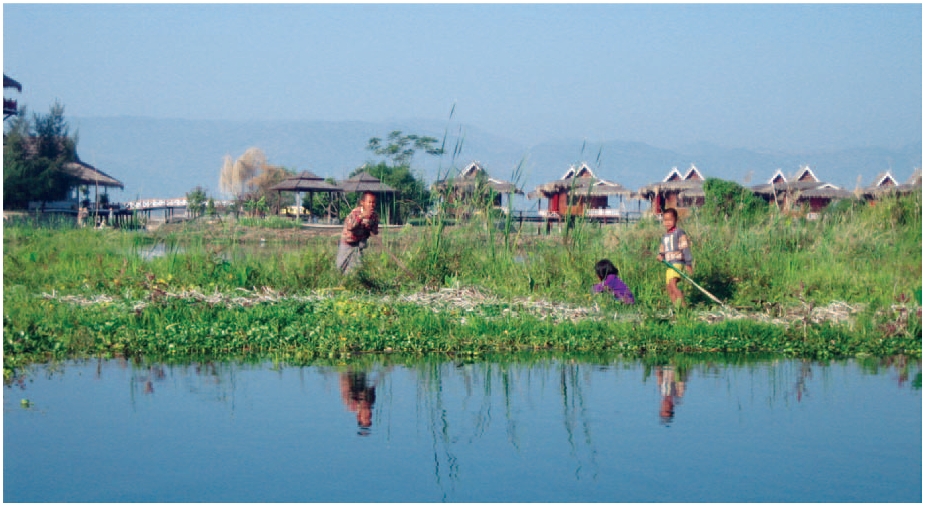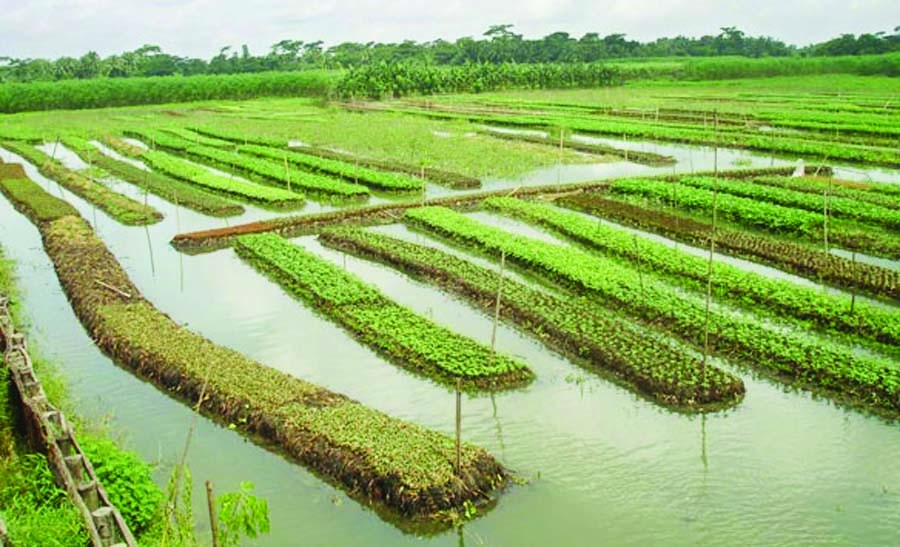Definition
Floating agriculture is a way of utilising areas which are waterlogged for long periods of time in the production of food. The technology is mainly aimed at adapting to more regular or prolonged flooding. The approach employs beds of rotting vegetation, which act as compost for crop growth. These beds are able to float on the surface of the water, thus creating areas of land suitable for agriculture within waterlogged regions. Scientifically, floating agriculture may be referred to as hydroponics (ClimateTechWiki, Floating agricultural system, accessed on Sept. 2016).Co-benefits and impacts
The practice helps mitigate land loss through flooding, by allowing cultivation of these areas to continue. In this way, the total cultivatable area can be increased and communities can become more self sufficient. In addition to this, the area under floating cultivation is up to 10 times more productive than traditionally farmed land and no additional chemical fertilisers or manure is required. When the crops have been harvested and floating rafts are no longer required, they can be used as organic fertilisers in the fields or incorporated into the following years floating beds as a fertiliser. The practice of floating agriculture also helps supplement the income of local communities and contributes to alleviation of poverty (ClimateTechWiki, Floating agricultural system, accessed on Sept. 2016).Conditions
While this technology works well in some areas today, it is unclear how it may be affected by Sea Level Rise and increases in salinity, which are likely to occur under scenarios of climate change. Additionally, while the technique is applicable in several mega-deltas such as the Ganges-Brahmaputra, the success of a more general application of this approach seems unlikely and caution is being recommended in applying this approach more widely (ClimateTechWiki, Floating agricultural system, accessed on Sept. 2016).Definition (GR)
Η υδρόβια γεωργία αποτελεί μία μέθοδος χρήσης πλημμυρισμένων, για μεγάλες χρονικές περιόδους, περιοχών για την παραγωγή τροφής. Η τεχνολογία στοχεύει κυρίως στην προσαρμογή σε πιο τακτικές ή παρατεταμένες πλημμύρες. Η συγκεκριμένη προσέγγιση μεταχειρίζεται στρώματα από σάπια βλάστηση, τα οποία λειτουργούν ως λίπασμα - κομπόστ για την ανάπτυξη της καλλιέργειας. Αυτά τα στρώματα μπορούν να επιπλέουν στην επιφάνεια του νερού, δημιουργώντας κατάλληλες γεωργικές περιοχές εντός των πλημμυρισμένων εκτάσεων. Επιστημονικά, η υδρόβια γεωργία μπορεί να αναφερθεί ως υδροπονική (ClimateTechWiki, Floating agricultural system, accessed on Sept. 2016).Co-benefits and impacts (GR)
Η πρακτική βοηθά στο μετριασμό της απώλειας γης λόγω πλημμύρας, επιτρέποντας τη συνέχιση της καλλιέργειας αυτών των περιοχών. Με αυτό τον τρόπο, η συνολική καλλιεργήσιμη γη μπορεί να αυξηθεί και οι τοπικές κοινότητες να γίνουν αυτάρκεις. Επιπρόσθετα, η γη όπου εφαρμόζεται η υδρόβια καλλιέργεια είναι πάνω από 10 φορές πιο παραγωγική, σε σύγκριση με την παραδοσιακά καλλιεργούμενη γη, και δεν απαιτούνται πρόσθετα χημικά λιπάσματα ή κοπριά. Όταν έχει ολοκληρωθεί η συγκομιδή των καλλιεργειών και τα πλωτά στρώματα δε χρειάζονται πλέον, μπορούν να χρησιμοποιηθούν ως οργανικά λιπάσματα στους αγρούς ή να ενσωματωθούν τα επόμενα έτη ως λιπάσματα στις υδρόβιες καλλιέργειες. Επίσης, η πρακτική της υδρόβιας αγροκαλλιέργειας βοηθά στη συμπλήρωση του εισοδήματος των τοπικών κοινοτήτων και συνεισφέρει στην ανακούφιση της φτώχειας (ClimateTechWiki, Floating agricultural system, accessed on Sept. 2016).Conditions (GR)
Αν και η τεχνολογία αυτή λειτουργεί καλά σε ορισμένες περιοχές σήμερα, είναι ασαφές πως μπορεί να επηρεαστεί από την άνοδο της στάθμης της θάλασσας και την αύξηση της αλατότητας, τα οποία είναι πιθανό να συμβούν με βάση τα σενάρια της κλιματικής αλλαγής. Επιπρόσθετα, ενώ η τεχνική μπορεί να εφαρμοστεί σε αρκετά μεγάλα ποτάμια δέλτα, όπως του ποταμού Γάγγη- Βραχμαπούτρα, η επιτυχία μιας γενικότερης εφαρμογής αυτής της προσέγγισης φαίνεται απίθανη και συνιστάται προσοχή στην ευρεία εφαρμογή της (ClimateTechWiki, Floating agricultural system, accessed on Sept. 2016).Last modified: June 18, 2020, 1:16 p.m.


 Ελληνικά
Ελληνικά

